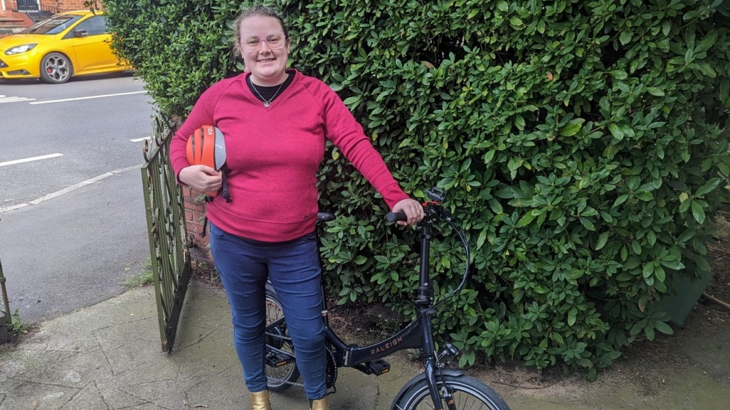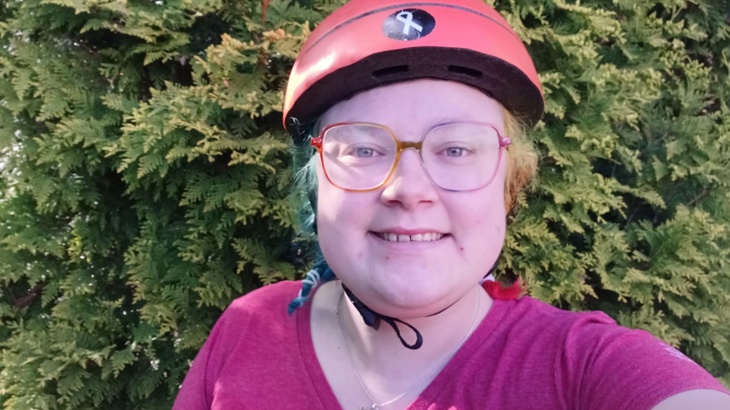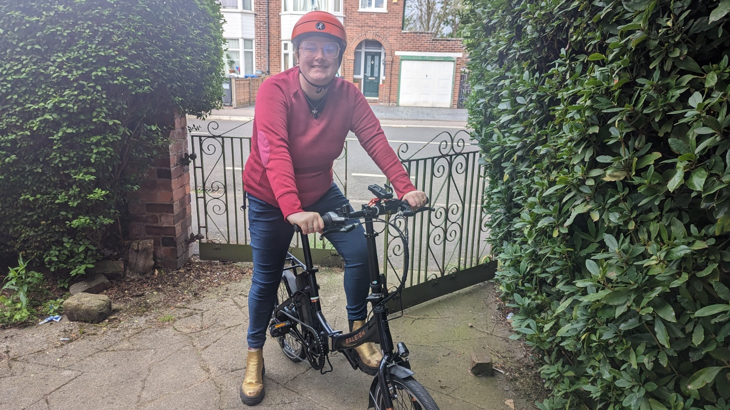For Bryony, who has endometriosis, finding comfortable ways of travelling by cycle has allowed her to continue working. It's helped reduce feelings of isolation and given her independence a boost. In this blog, Bryony talks about her experience of getting active and offers advice for anyone with the long-term condition who is thinking about getting on the saddle.

Bryony recently bought a fold-down electric bike, which means she can travel for longer distances without triggering pain. Credit: Bryony Carter
For some people, living with chronic pain can be debilitating and immobilising.
But getting active can often help with managing pain.
Bryony has endometriosis, a condition where cells similar to the ones lining the womb are found elsewhere in the body, causing inflammation and pain.
For her, embracing active travel has improved her independence, health and her work and social life.
My electric bike has allowed me to be more independent
Bryony, who takes codeine throughout the week to ease her daily pain, recently bought a fold-down electric bike.
This has helped her to travel for longer distances without triggering pain.
Standing and walking for long periods of time can be a painful experience, so she has found that using an electric bike is the perfect solution for her.
Bryony said:
“As a 29-year-old, I don’t want to sit on a mobility scooter to get around.
“Everyone experiences pain differently; my pain radiates down my legs and through my hips, which can make walking quite hard, especially for long periods of time.
“I also can’t stand up for long.
“With my electric bike, I can turn the power right up and it feels like you’re cycling downhill in gear one on a flat surface.
“It feels so easy, but I’m still exercising and getting places.
“What I love about cycling is that it can get you somewhere in eight minutes compared to the same journey which would take half an hour walking.
“Half an hour of walking would give me bad hip and lower back pain and I would then spend the rest of the day sat down.
“Cycling has allowed me to be more independent and flexible, it’s done wonders for my mental health.”
Living with a long-term health condition
Bryony, who lives in Stockport and works in North Manchester as a neighbourhood officer, was officially diagnosed with endometriosis in 2015.
This was following years of painful and heavy periods and “push back” from medical professionals when she was a teenager.
After being housebound for six weeks and unable to walk more than a few metres without sitting down due to pain, she decided to do her own research.
She found out more about her condition and identified her symptoms with help from Endometriosis UK’s website.
“That time in my life took a massive toll on my mental health, especially as a young person,” Bryony explained.
According to the charity which helped Bryony, endometriosis symptoms can vary in intensity from one person to another.
Some people may not experience symptoms at all, but for others it can be debilitating.
Endometriosis is a long-term condition and there is no cure, but Bryony has found ways of managing her pain and carrying on with daily life with the help of cycling.

Standing and walking for long periods of time can be a painful experience so Bryony has found that using an electric bike is the perfect solution for her. Credit: Bryony Carter
Finding the motivation to exercise when experiencing pain
Endometriosis UK recognises that navigating exercise and pain can be a challenge for those with the condition, but states that there is some evidence that movement can help alleviate painful symptoms.
Bryony explains:
“Exercise does help, but it’s hard to motivate yourself to do it when you’re in pain, bloated and haven’t slept.
“When you’re feeling like that, the last thing you feel like doing is getting on a bike or going for a jog.
“But distraction can be one of the best things for pain.
“Cycling is also great as it’s a low-impact exercise and it’s comfortable.
“The cycling movement and that stretching and opening up you get around your hips and legs is a lot better compared to walking.
“When I’m out on my bike I can feel my brain working in a different way, it’s so good for my mental health as well as my physical health.
“It’s all about finding the right balance with the length of a journey I do on my bike as too much strenuous exercise can also bring on pain which wasn’t there before. So, it can be a sticky situation to navigate.
“Through commuting, I’m able to exercise at the same time.
“Without my need and want for going to work, there’d be less motivation to get on my bike when I’m in pain.”
Cycling and using public transport has allowed me to continue working
Bryony, who lives half an hour away from her nearest train station, commutes to work using a combination of public transport and her electric bike.
Commuting in this way means she can preserve her energy and still get around even when she is experiencing pain.
“If had to do my commute all on foot I wouldn’t be able to go out as much as I would normally.
“I know this because with my condition, there are days when I just can’t physically do that much exercise all in one go.
“A lesser known symptom of endometriosis is chronic fatigue; I sleep between 10 and 11 hours a night and I’m still shattered every day.
“I don’t have the fitness to cycle around as much as I’d like to, but the bike’s motor takes the edge off and means I can go further.
“With my bike I know that on the days where I am in pain, I can still go out and do stuff. I can be more independent and flexible with my time.
“Doing my job brings me joy, a lot of satisfaction and a sense of reward.
“It puts me in a really positive place mentally when I get home and think ‘I’ve worked really hard today and I’ve been out and about on my bike too’.
“I love being outside and much prefer it to being on a bus, it’s quicker too.
“The great thing is I can still fully utilise public transport while commuting actively, I can hop on a tram and train, and it all feels very flexible and done to my own schedule.
“Getting around in this way has allowed me to continue working.”
When Bryony's not in work she uses National Cycle Routes like Fallowfield Loop (Route 6 and 60) and Rochdale Canal Tow Path (Route 66) to get around her city.
Combatting feelings of isolation
“With the bike being a fold-down I can take it into venues, which is really handy, especially as I work all over the place.
“It’s really helped with my social life too; I can cycle to a friend’s house then fold my bike down and put in a taxi on the way home. It’s great.
“I’m getting exercise while using a method of getting around that’s quick and easy.
“My sense of independence is really shaken when I’m going through those periods of bad pain.
“Having alternative methods of getting around has definitely given me my independence back.”

Bryony, who lives half an hour away from her nearest train station, commutes to work using a combination of public transport and her electric bike. Credit: Bryony Carter
Making adaptations to find a comfy position on a cycle
Bryony has found from trying different cycles that being in an upright position on her cycle is the most comfortable for her back.
She said:
“If I’m bent forwards in a position which you’d be on a road bike, this gives me back pain which is what I experience with my condition.
“My pain is triggered by being in bent forward positions and after standing up for a long time.
“I can sit much more upright on my electric bike which is great as on my old (manual) bike I found myself pushing back to straighten my back.
“I’m in the process of getting a wide, gel, cushioned saddle which I’m really looking forward to as my current seat sits my hips in an uncomfortable position.”
Advice for those with the condition thinking about getting on the saddle
According to Endometriosis UK, around 1.5 million women and those assigned female at birth are currently living with the condition in the UK.
Bryony’s advice for those with endometriosis who want to start cycling is “not to push yourself and to start off slow”.
She added:
“Start on somewhere flat, maybe at a park on a sunny day, and go at a leisurely pace.
“It’s important to do exercise but you don’t want to make life harder for yourself for no reason.
“If you experience this kind of pain for a while you might not be in shape, I’m certainly not in shape and I know my physical ability is low.
“It’s all about finding easy ways of moving and slowly building up.
“If you have a bike but you need to do a long journey, it’s worth considering getting an electric one, it’s been a game changer for me.
“Just keep in mind that getting out there, being brave and trying new things will all be good for you regardless of what you do.”
Since Bryony discovered Endometriosis UK, the charity not only helped her to recognise her symptoms, but connected her to a local support group of fellow people with the condition.
“There’s nothing like talking to other people who are experiencing the same thing.
“The support groups have been a lifesaver for me, I joined during a time when I was feeling absolutely miserable.
“I’ve been able to connect with an incredible support network of multigenerational people.”





